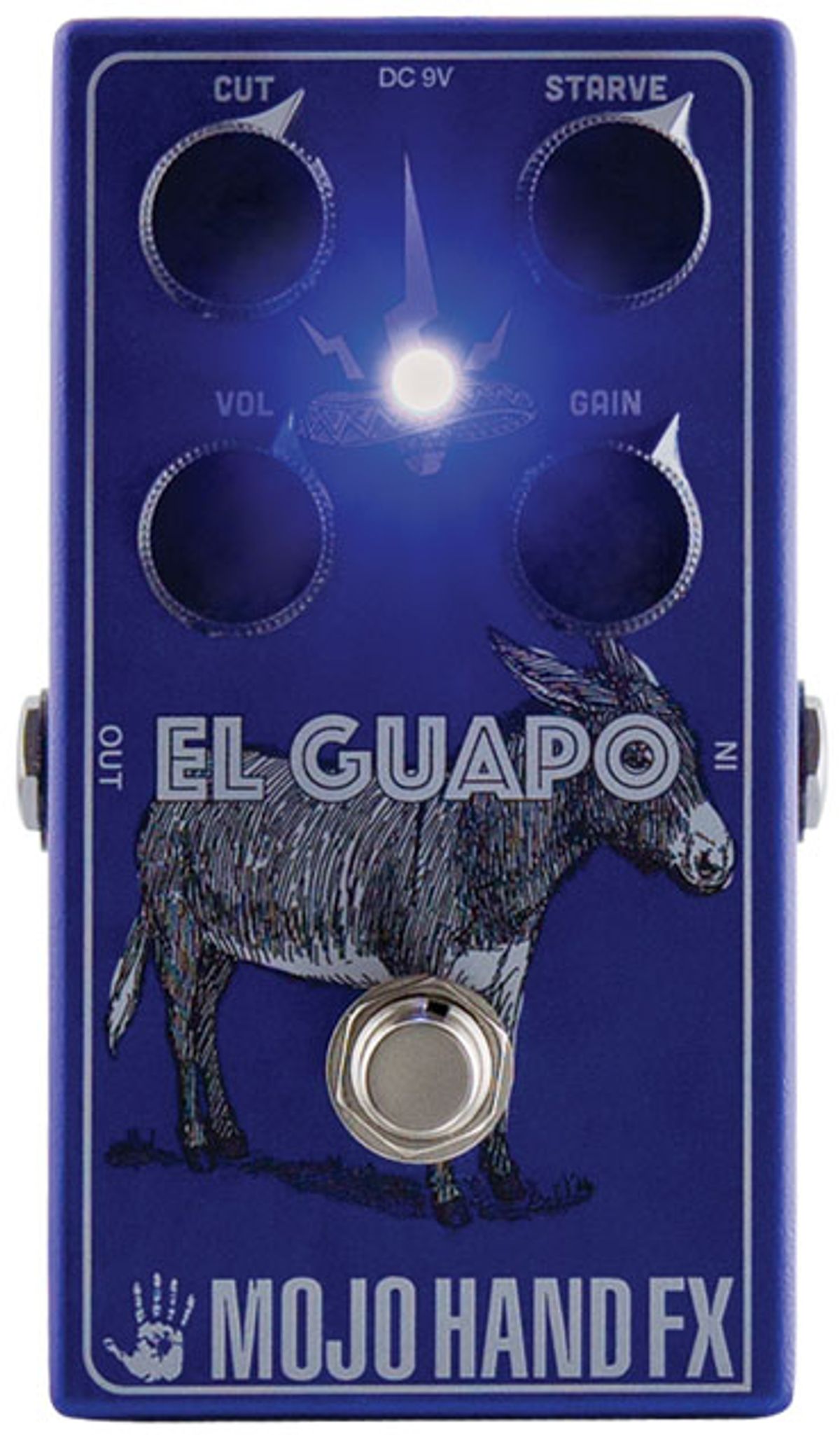
This silicon fuzz uses interactive controls and variable voltage to yield a fantastic array of shape-shifting sounds.
Once upon a time—not so long ago—fuzz was regarded in certain quarters as downright sleazy. Never mind that the effect helped shape classy sounding mega-million sellers from Dark Side of the Moon to the Isley Brothers’ “Summer Breeze.” By the late ’70s fuzz was held in low esteem—the essence of everything trashy, regressive, and vulgar. And whether you used a Fuzz Face, Tone Bender, or something more crude and terrifying, you huddled with fellow sleazoids in loose clans of outcasts and deviants.
Then a strange thing happened. Fuzz found favor again. And factions within those ranks of weirdoes began to appear. Suddenly “civilized” fuzz cultists (generally favoring smooth, germanium-derived vintage tones) sang the praises of the “few true” fuzz pedals with aristocratic tones and nose-upturned postures more associated with brandy aficionados. What Mojo Hand Fx has given us in the form of El Guapo is a shape shifting, variable-voltage, silicon fuzz that could potentially bridge the divide between the (yuck) connoisseurs and the outsiders that relish sputtering, sick, and more perverse fuzz cacophony.
Moon Indigo Madness
El Guapo is indeed handsome. A lot of fuzz box graphics have become mind-numbingly over the top in recent years. That’s cool. But there is something refreshingly imaginative, absurd, and Dadaist about a burro peeking from behind the “O” and an upturned sombrero emitting bolts of lightning that surround the LED.
It’s handsome on the inside, too. The surprisingly simple circuit is neatly arrayed on a flawlessly populated PCB. The I/O and 9V jacks are board-mounted, but the whole unit is so sturdy and sound it’s hard to imagine this being a problem. You also have the option to power the pedal with a 9V battery.
From Uptown to the Gutter
El Guapo is deceptively complex, so it isn’t the easiest fuzz to decipher or understand fluently. The controls are highly interactive and, individually, can seem extraordinarily sensitive. But they each have great range and make creating sounds and textures fun and rewarding if you have a little patience. And as much as the pedal invites (and occasionally requires) attentive tinkering, it’s easy to get great sounds—especially with a smaller tube amp running on the aggressive side of its sweet spot. Just about any setting with all four controls in the vicinity of noon will drive your amp into a cool overdriven zone.
Much has been made of El Guapo’s abilities as an overdrive. And while it’s certainly capable of nice low-gain drive tones, that isn’t the pedal’s strongest suit. Low-output humbuckers that can add a touch of color in the low-mid range are the best fit for this application and a great match for El Guapo in general. Single coils fare less well, and tend to sound relatively brittle and one dimensional—particularly if you use guitar volume dynamics to clean up your signal. That said, you can coax some pretty sweet low-gain lead tones from a Stratocaster if you soften your guitar tone and set the pedal’s effective cut control in a spot that suits your amp.
Ratings
Pros:
Surprising range of fuzz colors. Dynamic, interactive cut and voltage-starve controls. Great with small amps. Huge studio potential.
Cons:
Low-gain drive tones can sound thin with single coils.
Tones:
Ease of Use:
Build/Design:
Value:
Street:
$175
Company
mojohandfx.com
Mid-gain tones start to highlight the sweetest facets of El Guapo’s voice and the interactive possibilities of the gain, starve, and cut controls. Players frustrated with the limitations of vintage fuzzes like Fuzz Faces and Tone Benders (which sometimes require maxed-out gain settings to get the best sounds) will be delighted at how deliciously fuzzy El Guapo sounds with the gain control well left of noon. With small amps in particular, gain settings in the 10-to-2 o’clock range sound especially sweet and bigger than life. Bigger amps will happily take a bit more gain, but also sound huge and buzzy in the mid-gain zone. This adds up to a lot of fuzz colors and moods.
Variable voltage controls aren’t new. They’re a common mod among Fuzz Face-style circuit tweakers and a big part of what makes ZVex’s Fuzz Factory so delightfully bonkers. El Guapo’s take on the voltage starvation concept, however, yields many unique textures. Dramatic octave effects can be achieved by turning the gain and starve controls way up and adding extra high end with the cut control. Tweaking the cut control and your guitar tone and volume can generate even wilder, sputtering, gated and ring modulator-style effects.
The Verdict
The magic of Mojo Hand’s El Guapo is how readily it dwells in the worlds of the crude and the well mannered. The interactive and sensitive tone and voltage controls are effective and beg for experimentation. And the gain control offers enough shades of fuzz to suit everything from clear, stinging Fuzz Face fare to scuzzier, more demented garage punk filth. This versatility makes it easy to imagine El Guapo as a studio MVP—the kind of superstar, situationally flexible fuzz that can re-shape the personality of a song or riff entirely. And while its copious quirks might make it less easy to use as a primary fuzz in performance, the possibilities of unleashing a rabid El Guapo as contrast to more conventional fuzz tones are positively delicious to consider. PG

